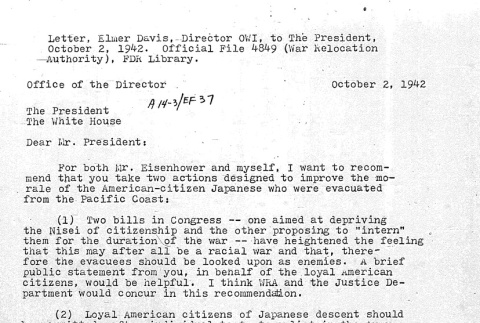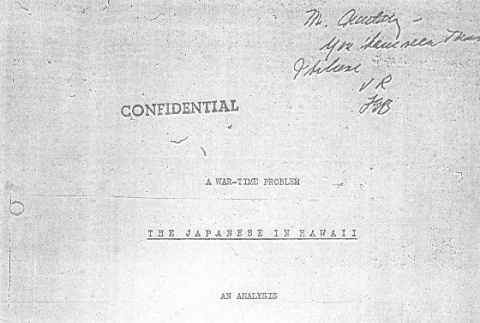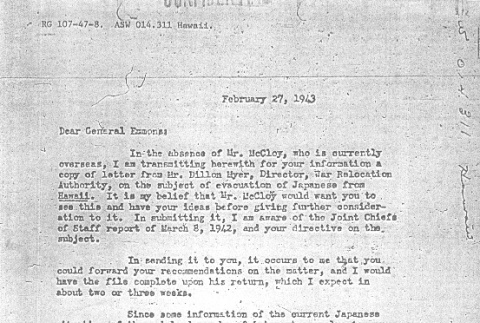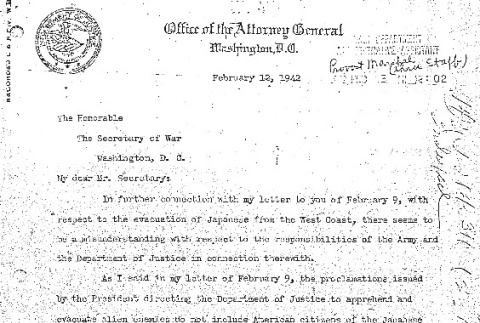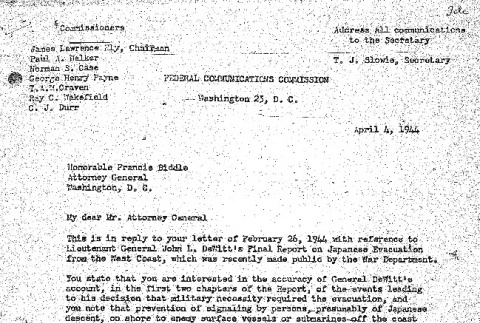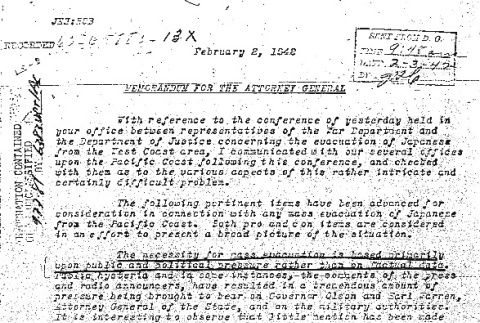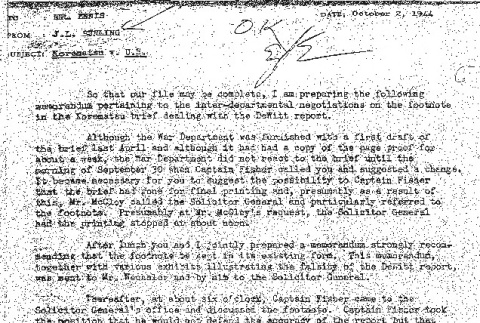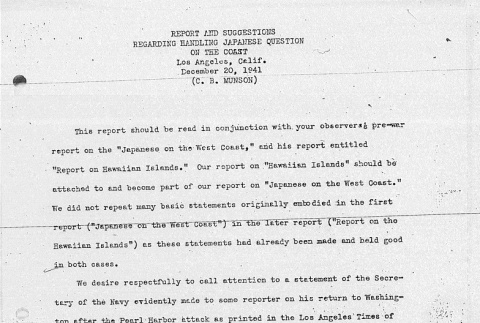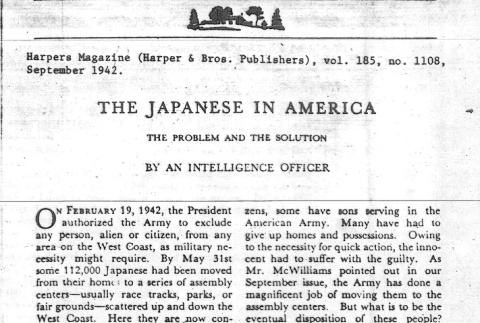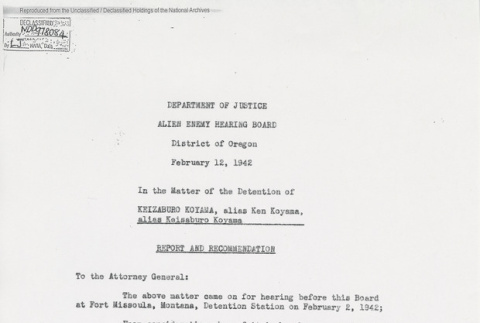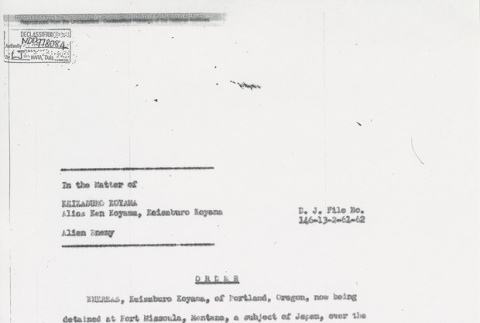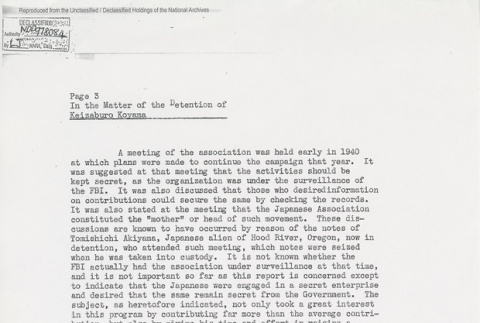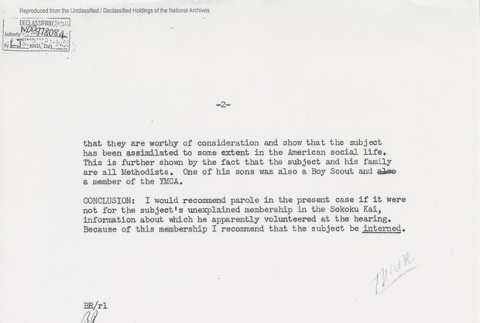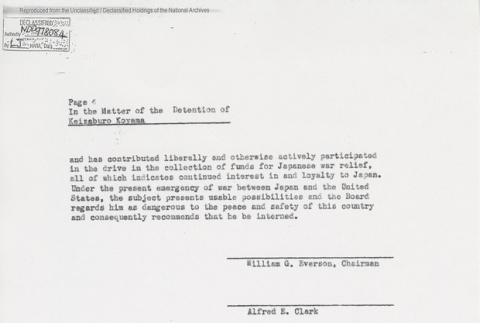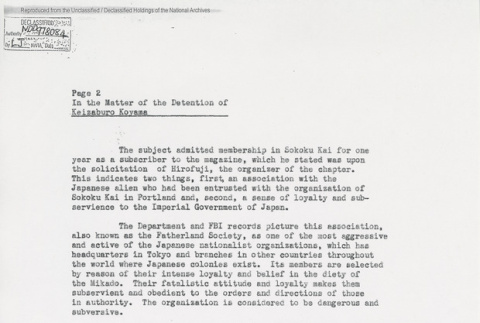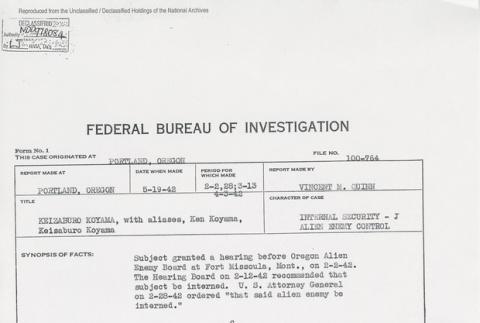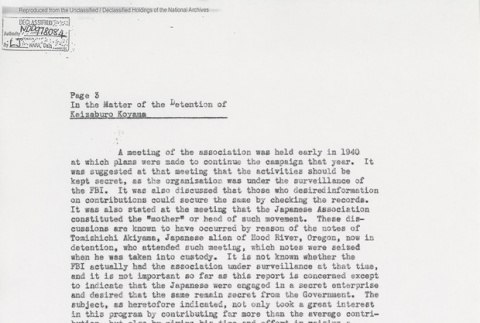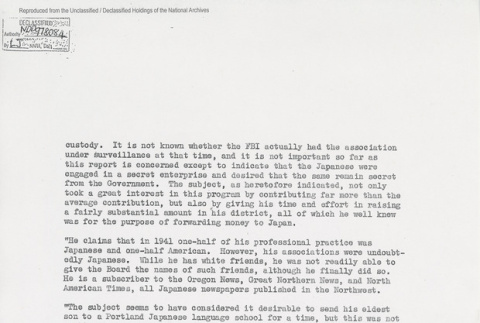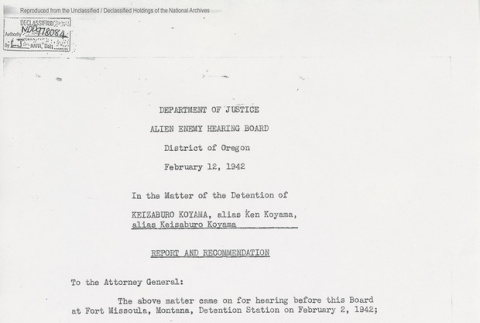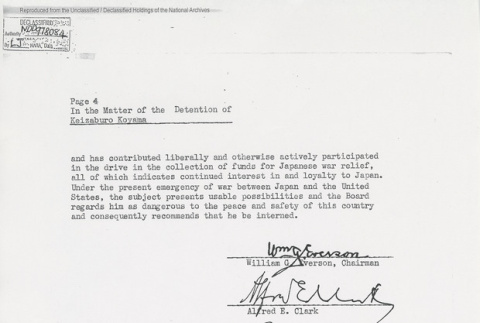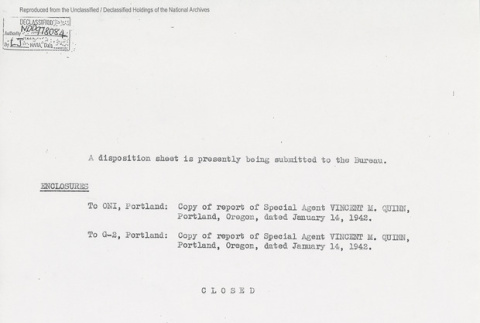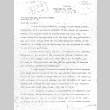Decision to incarcerate
World War II
(231)
Pearl Harbor and aftermath
(251)
Decision to incarcerate
(119)
Related articles from the
Densho Encyclopedia :
John DeWitt,
Executive Order 9066,
Final Report, Japanese Evacuation from the West Coast, 1942 (book),
Leland Ford,
Allen Gullion,
Frank Knox,
John McCloy,
Munson Report,
Roberts Commission report,
Franklin D. Roosevelt,
Henry Stimson,
The Fifth Column on the Coast,
Tolan Committee,
Earl Warren,
Western Defense Command
119 items
119 items
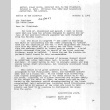
doc
Letter to President Roosevelt from Elmer Davis (ddr-densho-67-82)
Letter to President Roosevelt from Elmer Davis. Davis suggests that President Roosevelt publicly respond to allegations that the war is racial. Also suggests that the President open voluntary enlistment to the evacuees. Seems concerned about Japanese propaganda in Asia, which also calls the war a "racial war." Davis urges the President to consider intelligence reports of …
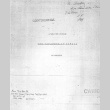
doc
Report: "A War-Time Problem: The Japanese in Hawaii" (ddr-densho-67-63)
Extensive report based mainly on observations and U.S. census materials. Argues that Japanese are a threat to military security in Hawaii and something must be done to handle the situation. Presents a number of facts that he thinks support this, analyzes these facts, and suggests possible plans. These include total evacuation of certain areas, creation of …
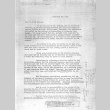
doc
Letter from Col. William Scobey to Gen. Delos Emmons (ddr-densho-67-55)
Letter from Col. William Scobey to Gen. Delos Emmons on the status of Japanese Americans on mainland. Discusses failure of voluntary induction in the army due to "resentment" and "anti-American" kibei and issei. Mentions segregation of loyals and disloyals as not happening because of lack of space. Suggests to Emmons that these complications have prevented evacuation …
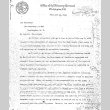
doc
Letter from Francis Biddle to Henry Stimson (ddr-densho-67-99)
Letter from Francis Biddle to Henry Stimson discussing possibility of evacuation. Biddle states that the Department of Justice has no authority to evacuate American citizens and legal problems could arise if the army chooses to evacuate. Urges Stimson to consider his suggestions before he makes a decision.
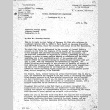
doc
Letter from the FCC to Francis Biddle (ddr-densho-67-76)
Letter from the Federal Communications Commission (FCC) to Francis Biddle on radio signaling as described in DeWitt's Final Report. The FCC reviewed their records and found that there was no evidence of any illegal signaling during Dec. 1941 - July 1942. The FCC also refuted two other things that DeWitt told Biddle justifying evacuation - the …
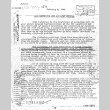
doc
Excerpt from a memo from J. Edgar Hoover to Francis Biddle (ddr-densho-67-102)
Excerpt from a memo from J. Edgar Hoover to Francis Biddle regarding evacuation. Hoover assesses the situation on the West Coast due to the pending Executive Order. Concludes that although mass removal is based on race hysteria, Japanese Americans still pose a threat because of their loyalty to Japan. Suggests that in the case of an …
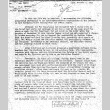
doc
Memo to Edward Ennis from J.L. Burling (ddr-densho-67-103)
Memo to Edward Ennis from J.L. Burling on DeWitt's final report and the Korematsu brief. States that the Department of War and the Department of Justice are fighting over a footnote in the Korematsu brief that mentions the Final Report. They eventually compromise in order to reduce departmental tension.

doc
C.B. Munson's "Report and Suggestions Regarding Handling Japanese Question on the Coast" (ddr-densho-67-5)
Suggestions in this report include accepting nisei into the war effort and defense industries, and putting responsibility for behavior and food production on nisei groups and leaders.
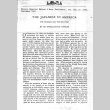
doc
Harper's Magazine article: "Japanese in America: the Problem and Solution" (ddr-densho-67-129)
Harper's magazine article written by an Intelligence officer. He describes evacuation and internment, critiques internment and says that most of the internees are loyal.
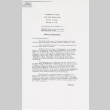
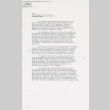
doc
Department of Justice Alien Enemy Hearing Board Report and Recommendation page 2 of 4 (ddr-one-5-154)
Photocopy of a declassified report detailing the reasoning behind the recommendation that Dr. Keizaburo Koyama be interned as an alien enemy. The second page presents as evidence his involvement with the Sokoku Kai [Fatherland Society]. The FBI felt that this lead to a "sense of loyalty and subservience to the Imperial Government of Japan." The FBI …

doc
Federal Bureau of Investigation Case file for Keizaburo Koyama. Page 2 of 4. (ddr-one-5-170)
Photocopy of a declassified file on Keizaburo Koyama by the Federal Bureau of Investigation. This page goes into greater detail the reasoning for interning Koyama. The FBI has labeled the Fatherland Society as "one of the most aggressive and active of the Japanese nationalist organizations...It's members are selected by reason of their intense loyalty and belief …
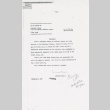
doc
Court order on the internment of Keizaburo Koyama (ddr-one-5-163)
Photocopy of a declassified court order stating that Keizaburo Koyama, having been found to be an enemy alien, be interned immediately.
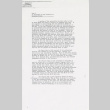
doc
Department of Justice Alien Enemy Hearing Board Report and Recommendation page 3 of 4 (ddr-one-5-155)
Photocopy of a declassified report detailing the reasoning behind the recommendation that Dr. Keizaburo Koyama be interned as an alien enemy. This page continues with the assessment of the Japanese Chamber of Commerce. The Chamber felt it was under FBI investigation in 1940 and someone there suggested they conduct their meetings in secret. The report states …

doc
Reconsideration page 2 of 2 (ddr-one-5-162)
Photocopy of a declassified document labeled "RECONSIDERATION." The writer states that he would have recommended parole based on he and his family being Methodist and his son a member of the Boy Scouts, but due to his membership in Sokoku Kai, he believes that Keizaburo Koyama should be interned.
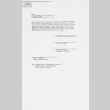
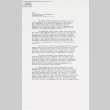
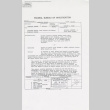
doc
Federal Bureau of Investigation Case file for Keizaburo Koyama. Page 1 of 4. (ddr-one-5-169)
Photocopy of a declassified file on Keizaburo Koyama by the Federal Bureau of Investigation. The document speaks on Koyama's hearing at Fort Missoula, Montana and being found to be an enemy alien. The decision was based largely on Koyama having a subscription to the magazine put out by the Sokoku Kai. The panel felt that his …
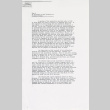
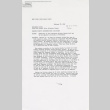
doc
Reconsideration page 1 of 2 (ddr-one-5-161)
Photocopy of a declassified document labeled "RECONSIDERATION." It finds that Keizaburo Koyama should be interned due to being a member of the Fatherland Society (Sokoku Kai) and the Japanese Association of Portland. Despite having letters signed by 15 white Americans affirming his loyalty, the board did not consider their testimony as the letters were not submitted …
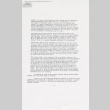
doc
Federal Bureau of Investigation Case file for Keizaburo Koyama. Page 3 of 4. (ddr-one-5-171)
Photocopy of a declassified file on Keizaburo Koyama by the Federal Bureau of Investigation. The report notes that cannot verify if the FBI actually had the Japanese Association under surveillance, but the secretive activities of the group warranted greater scrutiny. The FBI does not find Koyama to be a Japanese leader, but his continued financial support …
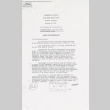
doc
Department of Justice Alien Enemy Hearing Board Report and Recommendation page 1 of 4 (ddr-one-5-153)
Photocopy of a declassified report detailing the reasoning behind the recommendation that Dr. Keizaburo Koyama be interned as an alien enemy. The first page notes those individuals that wrote on his behalf, but since their letters were not in affidavit form, they failed to comply with the Department's regulations for the conduct of alien hearings. As …
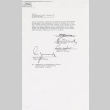
doc
Department of Justice Alien Enemy Hearing Board Report and Recommendation page 4 of 4 (ddr-one-5-156)
Photocopy of a declassified report detailing the reasoning behind the recommendation that Dr. Keizaburo Koyama be interned as an alien enemy. This page concludes the decision to intern Dr. Koyama as an enemy alien since his involvement with organizations like Sokoku Kai and the Japanese Chamber of Commerce may lead to him show disloyalty to the …
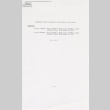
doc
Federal Bureau of Investigation Case file for Keizaburo Koyama. Page 4 of 4. (ddr-one-5-172)
Photocopy of a declassified file on Keizaburo Koyama by the Federal Bureau of Investigation. The final page of the report indicates what enclosures were included.
